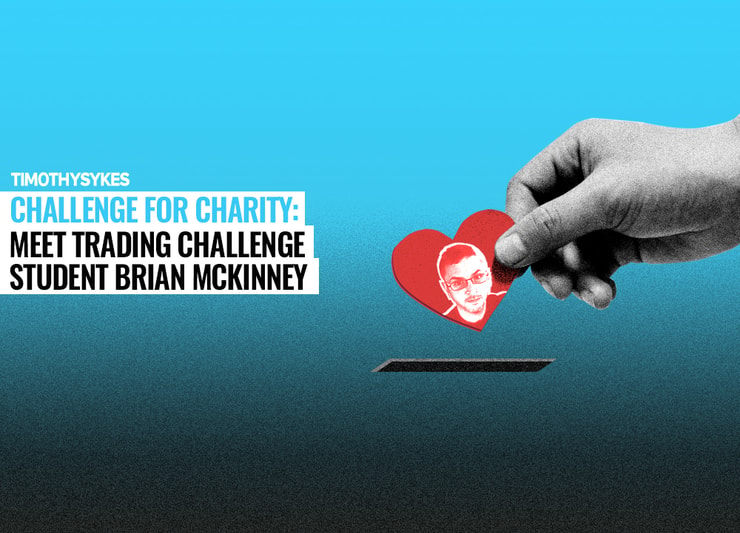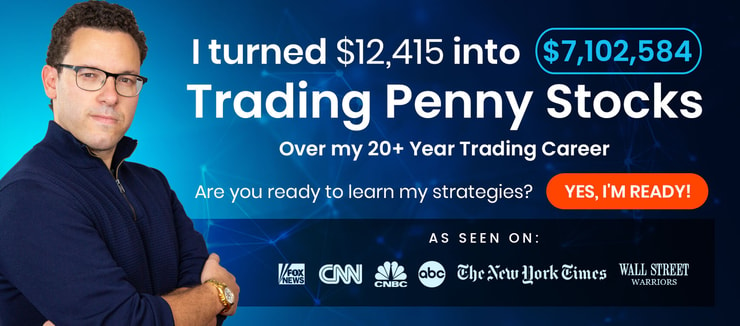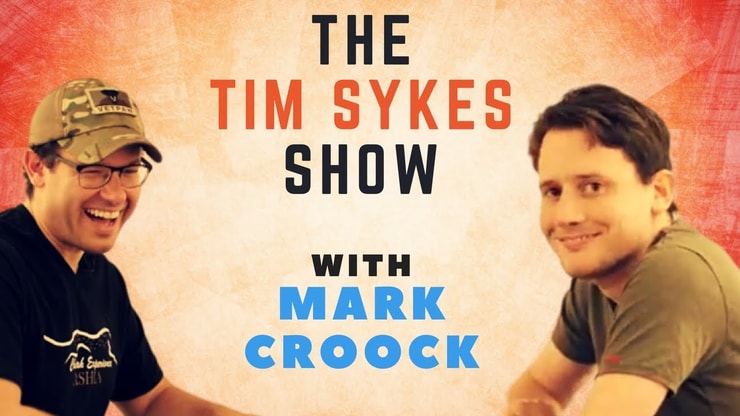Today I want to share an inspiring challenge for charity. Usually, students hit six figures in profits before I highlight them on the blog. Even then, it’s not a sure thing. But Brian McKinney and Sari Manap caught my attention.
They joined the Trading Challenge at roughly the same time in April. Neither has reached $100,000 in profits … They’re just getting started on their journeys.
But even though they’re trading with small accounts, they challenged each other. And not just to trade better. They challenged each other to donate some of their profits to charity. I’m so proud of them and their efforts I had to share it here.
The cool thing is, they’re inspiring others to do the same. I recently caught up with Brian (aka DocBrian) on his trading journey, the challenge for charity, and more. Get inspired…
Table of Contents
- 1 Challenge for Charity Q&A With Brian McKinney
- 1.1 What got you into trading?
- 1.2 You’re in the Trading Challenge and also Mark Croock’s Evolved Trader program. Why both strategies?
- 1.3 You were in the military. Has that experience helped as you learn to trade?
- 1.4 What inspired you to start donating trading profits to charity?
- 1.5 How do you decide how much to donate to your challenge for charity?
- 1.6 How has the challenge for charity affected your trading mindset?
- 1.7 Are you passionate about any specific charities or causes?
- 1.8 Do you have a long-term goal for your donations or charity work?
- 1.9 What trading strategies are working best for you?
- 1.10 What would you say to other traders about donating to charity?
- 1.11 How important has the Trading Challenge community been for your learning?
- 1.12 What’s your advice for someone considering the Trading Challenge or Evolved Trader?
- 2 I LOVE Student Successes!
- 3 Are You Ready to Step Up to the Challenge for Charity?
Challenge for Charity Q&A With Brian McKinney

For this post, I did a Q&A with Brian. Hopefully, we can feature Sari in a future post, because as Brian puts it…
“She really helps me stay centered and reminds me to be patient. She has been through a lot and is a major inspiration.”
I love that Challenge students help each other! Now for the Q&A…
What got you into trading?
Brian: My first attempt at trading was after the market crash in 2008. I remember asking my professor if I could step outside during anatomy lab to sell at the market open. He laughed and said in his entire career he’d never been asked that. He let me do it and even watched.
That said, I had no clue what I was doing. I actually remember telling a friend, “This market is so crazy, even an idiot can make money!”
That idiot was me. While I grew my small account in a few months, I lost that much and more when the market bottom fell out. After that, I cut my losses and focused on my medical career.
Fast forward to 2020…
This pandemic happened and the market crashed. I remembered the opportunity that existed in 2008. One day I saw an ad for your Trading Challenge, and a spark was lit. I discussed it with my family and decided to try it, determined to avoid the mistakes I made in 2008.
You’re in the Trading Challenge and also Mark Croock’s Evolved Trader program. Why both strategies?
Brian: I joined for multiple reasons…
First, after watching Mark live trade in webinars, I realized I had a similar trading style. I also liked Mark’s teaching style.
But more importantly, learning to trade has not been easy for me. There have been weeks where this Challenge feels like an uphill climb and my profit curve felt like a cliff. I realized that if I want to succeed, I need to learn how to use every tool available. And find every advantage possible.
That’s what ultimately led me to invest in Evolved Trader even though it felt like a risk at the time. It was a big unknown. I’ve found in the current market it fits better with my style of trading. In a calmer market, it might not work. That’s why I always want to learn more and adapt.
More Breaking News
- MIRA Pharmaceuticals: What Drives Latest Fluctuation?
- First Solar Stock Receives Positive Momentum Amid Target Price Raises
- Windtree Therapeutics’ Soaring Stock: What to Expect?
You were in the military. Has that experience helped as you learn to trade?
Brian: Plebe Summer at the U.S. Naval Academy taught me that I can do anything for four weeks. Then I can do it again for four more weeks. (Plebe Summer was eight-weeks long.) I’ve endured many things with this mentality. The Trading Challenge is an endurance test.
The military has a concept of “mission first.” Another way of saying “mission first” is “big picture first.” No one trade will win the war, but one bad loss can sink the ship. My success is defined by what happens over 200 or 2,000 trades, not my next trade.
One great trade will not win the war,
But one bad loss can sink the ship. #HumbleThoughts #GoNavy
cc: @tbohen @timothysykes @NDTMC
— DocBrian (@DocBrianTrades) August 27, 2020
What inspired you to start donating trading profits to charity?
Brian: It was a challenge between myself and another Trading Challenge student, Sari Manap. (See Sari’s Profit.ly page here.)
After some big losses early on, I started looking at my mindset. Sari and I talked over our trades. I started asking myself questions. “Why do I not cut losses quickly enough?” or ”Why am I holding and hoping?”
I felt that being greedy was at least part of the issue. Greed was leading me to not protect my profits and cut losses quickly. More is always better, right? (Hint: it’s not.)
When I want to stop a bad habit, I look for the opposite quality or behavior. What’s the opposite of greed? For me, it was giving and being thankful.
You always talk about how “the money doesn’t matter in the beginning.” So, I proposed a trade experiment with Sari:
Why don’t we set aside a specific time frame to trade for charity?
Sari liked the idea, too, and we both agreed to try it. We wanted to see if giving up profits on purpose affected how we trade.
How do you decide how much to donate to your challenge for charity?
Brian: Sari and I challenged each other. On our first profitable day (i.e., first green day) each month, we donate 100% of our profits to a charity of our choice. We call it the #FirstGreenDay challenge.
In June and July, our profits were around $100–$200 each. Easy enough, and we were happy to donate. Then in August, we each made over $3,000 in profits on our first green day!* But the challenge was still on, so we continued to donate. And we look forward to more #FirstGreenDay donations.
We hope other traders will consider trying the #FirstGreenDay challenge. But we’re also just happy to see more people giving — even if it’s just a fraction of their profits.
How has the challenge for charity affected your trading mindset?
Brian: Giving has dramatically changed my mindset. I still make mistakes and have much to learn. Being able to give is now a short- and long-term goal. Having that goal helps me be more mindful of my profits and protect them.
It has a huge effect on how I trade or choose not to trade. And it’s a process. Change doesn’t happen overnight. Like I said before: I’m not even at 1% of where I want to be.
Giving also helps me find the resilience to endure losses. I had a $3,000 loss recently. It was not fun. I had to really evaluate where I messed up. That’s a totally new mindset than where I was in May.
Are you passionate about any specific charities or causes?
Brian: I’m passionate about helping people directly and meeting basic needs.
So far, I’ve looked to give to…
- Charities that help veterans and their families like Wounded Warrior Project.
- Disaster-relief charities, including to help Yemen, Lebanon, and Mauritius via Karmagawa.
- A faith-based nonprofit called UIM International that is helping families affected by COVID-19. (Like my own has been.)
- Charities that support families and/or children with disabilities. Extra Life is a pretty cool charity in the gaming community.
Do you have a long-term goal for your donations or charity work?
Brian: Long term, Sari and I would love to start a charity that grows out of our #FirstGreenDay concept. First, we need to become self-sufficient and consistently profitable traders.
Planning to donate any potential profits during @timothysykes next All Day Trade/Teaching with MarketMastery to help #CaliforniaFires @NDTMC @JakTradeDDS @JaretRoberto (and I will have my quarter jar ready to remind me not to take unnecessary trades). https://t.co/tulVq4jI0N
— DocBrian (@DocBrianTrades) August 25, 2020
In that tweet, Brian mentions Market Mastery. The next day of live trading will come around again soon enough…
Join me for the next Market Mastery 2020 session.
What trading strategies are working best for you?
Brian: I love testing. My goal is to learn every pattern so I can be flexible and adapt to whatever the market throws at me. I have a long way to go.
I’m using different strategies for stocks versus options…
With options, I look for technical breakouts. I’m also starting to trade first red days. It took over a month of studying only first red days for me to have a little success on my own. I’ve had some bang-my-head-against-the-wall moments, though. For example, I bought Kodak puts on the first green day. I’m still learning.
Even though Brian had a loss on that trade, he was completely transparent about it. He also learned why it’s so important to follow rule #1: cut losses quickly!
With stocks, I’m having success with a pattern I call the cup-handle-pop. I was in knots at first because it’s my #1 pattern and it’s not one of your patterns. I even avoided trading it for a while until my data showed I cannot ignore it.
I’ve also had some success with premarket news spikers and panic dip buys. That said, I recognize how hot this market has been. So I want to keep learning more patterns.
Just amazed! Huge ty to @timothysykes @30DayBoot @StocksToTrade . Just made $2k in 3 min ($25 shy so I rounded😉)!
But really, ya'll, Tim is right--This is the POWER of education and studying: $2k in 3 min. 2 months ago I would have avoided a sub-penny stock/Supernova. pic.twitter.com/5OWGPBl5MY
— DocBrian (@DocBrianTrades) August 24, 2020
My #1 goal is to “stay in the arena.” 2008 came and went. 2020 will come and go. I have to be ready to stay, even if I decide to take time off. I keep reminding myself that I’m not even at 1% of where I want to be. That helps keep me humble.
Want to see all Brian’s trades? He goes by DocBrian on Profit.ly.
What would you say to other traders about donating to charity?
Brian: Try it!
Sari and I did this as a test to see how it affected our trading mindset. We were so impressed with the results and had so much fun that we kept doing it every month. Now it’s a challenge for charity between the two of us — and it’s still fun.
Brian also shares about his donations on social media. To show you how powerful that can be, check this out…
People ask me all the time why I’m so vocal about sharing. They accuse me of virtue signaling or bragging. That’s BS. This is a perfect example of why I share and why Karmagawa uses social media to spread the word.
How important has the Trading Challenge community been for your learning?
Brian: The Challenge has been unusual in that we say, “Trading is you vs. you.” I think that’s a very wise mentality. After all, it’s just you and the screen.
But in the military, we talk about esprit de corps or “common spirit.” I’m impressed with the level of community in the Challenge. There are several people I consider good friends — including my trading buddy, Sari.
Also, I’m really encouraged when I see the community give back. Like when Karmagawa raised over $250,000 in 24 hours and the average donation was $28. What an incredible show of support!
As for learning…
I once read that you retain 90% of the information that you explain to someone else. I love it when people ask me questions on Twitter — especially when I don’t know the answer. I’ll go look it up or find one of your blog posts explaining it. I learn more by people asking me questions.
What’s your advice for someone considering the Trading Challenge or Evolved Trader?
Brian: If you’re willing to learn and be patient I think it’s worth your time. Penny stocks and options can be risky, so you have to decide if that risk is appropriate for you. Both you and Mark teach risk management. That said, sometimes the unthinkable happens.
If you’re brand new to penny stocks, start with my FREE penny stock guide.
For Mark’s program, I hear a lot of people say “I need to learn the basics before I learn options.” I thought that way, too. But people don’t realize that Mark is teaching your Pennystocking Framework. He’s just using options to apply it to larger companies.
I do think the conservative techniques you teach make me a better options trader. And I believe the strategies Mark teaches make me a better penny stock trader.
Personally, I’ve found what I was looking for in two programs that synergize well. They’re helping me to find every advantage possible, one day at a time. There’s a benefit to being a lifetime member in the Trading Challenge and Evolved Trader. I’ve accepted that this really is a marathon. It takes off some of the pressure to succeed right now.
I LOVE Student Successes!
Every year I start over with a small account and donate profits to charity so I can prioritize teaching. When students like Brian and Sari start to get it, that makes me more proud than how much I make from trading.
I’m also super proud of Trading Challenge mentors like Mark Croock. These chat room comments from Brian say it all…
DocBrian → timothysykes: wow, I really got focused on myself this weekend and just really introspected on my mistakes--alot of them— I’m up $4k and now I’m going to enjoy the rest of the day off…. ty Tim and ty Mark very much, I want to go stay humble and plan how I’m going to protect these profits this week. ty so much.
DocBrian → timothysykes: could have never done this without you and Mark, just seriously floored right now.
If you want to be a lifetime Trading Challenge student like Brian, contact my team here. I’m not sure how much longer we’ll keep this open. So if you’re serious, do it today.
Are You Ready to Step Up to the Challenge for Charity?
It’s my honor to donate 100% of my trading profits to charity. Now I’m inspired by the #FirstGreenDay challenge that Brian and Sari put together. I hope you get inspired and donate some of your trading profits, too.
When more traders get involved we can change the world. So when you donate, share it on social media!
Help those affected by the California fires here.
Will you step up to the challenge for charity? Comment below and let Brian and Sari know how inspired you are!
(*These trading results are not typical. Individual results will vary. Most traders lose money. My top students have the benefit of many years of hard work and dedication. Trading is inherently risky. Always do your due diligence and never risk more than you can afford to lose.)












Leave a reply